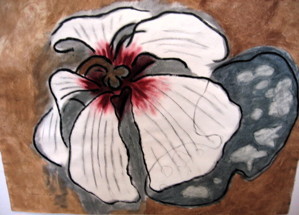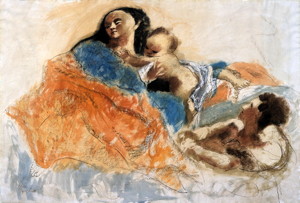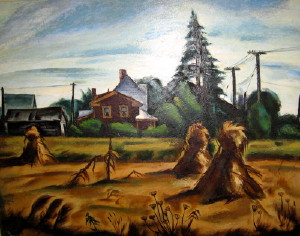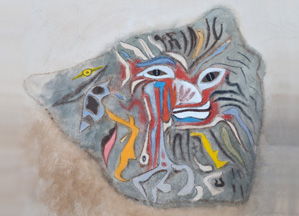| |
|
|
|
|
Oils
Culver rarely painted in oil after the 1930s. The early oils tend to focus on the dark, somber colors of construction and industrial sites, farmland and old barns around southern Michigan, and a few experimental abstracts. A trip to Mexico in 1935 generated paintings both in oil and watercolor. Portraits of family members and still lifes were also done in oil during those years.
Having painted in oil during much of his early career, by the beginning of the 1940's he had begun the transformation to watercolor, and by late 1948 had switched permanently to watercolor, with very few exceptions. Culver's watercolors were focused on two genres: landscape and animals. |
Click picture to view works |
|
|
|
|
|
|
|
|
|
Landscapes
Many of Culver's landscapes focused on the fall and winter seasons for their moods. Some of his most beautiful landscapes feature soft mossy browns, grey blues and snow. Water was a common and favorite subject. He would travel around northwestern Michigan to paint scenes around Torch Lake, Intermediate Lake, Lake Bellaire, and Lake Michigan.
He would sketch farmland, mostly without dwellings, making notes of the colors before returning to the studio to paint. He also produced a small series of houses in the area that were interesting to look at for color or architecture. |
Click picture to view works |
|
|
|
|
|
|
|
|
|
Animals
Charles Culver is probably most well-known for his animal portraits. One of his first was a six-toed cat belonging to the family and went on from there to include deer, ducks, exotic birds, cows, common forest animals such as raccoons and skunks, and wild beasts he could look at in zoos. This is not to say that he ignored other members of the animal kingdom; he painted snakes, bats, bees, toads, birds, and dragonflies. He created multiple series of paintings of spiders, mosquito hawks, moths, as well as the occasional scorpion.
These paintings are distinctive, recognizable usually by a background of a soft mottled coloring, and a watercolor technique that never looks washed out and, in later years, he began adding wax to the outline of the animal or in the background of many of the works. |
Click picture to view works |
|
|
|
|
|
|
|
|
|
Stones
In the spring of 1950, while on a stroll along the Torch Lake shore, he found a small brown stone with a pattern on its surface. It suggested to him a group of prehistoric animals. This particular stone became "Primitive Beasts," the first of his many stone series paintings. The stone series mostly related to animals because his imagination almost always extracted some primitive beast or animal-like stick figure from each stone he picked.
In a preface to an exhibit of his first stone series water colors at the Macbeth Gallery in New York, he wrote, "In stones, with their patterns and imbedded fossils, I have discovered a new world not like our own. In it are beings, beasts, birds and reptiles of species heretofore unknown and unclassified."
These new works presented much more radical and expressionistic images than previously. Yet the new paintings remained essentially responses to the facets, fragments and view of the fascinating microcosms of nature to be seen in stones, as he thought his work should always be. |
Click picture to view works |
|
|
 |
|
Flowers
Culver preferred plants and flowers in an unaffected setting rather than in an arranged still life. Many times, he would focus on a single representative of a particular bloom: a stalk of gladiola, an orchid, or a hyacinth. Again, with the classic mottled background that he used extensively in the animal paintings.
|
Click picture to view works |
|
|
 |
|
Weeds
In another year, he spent several months concentrating on weeds, which were executed with quick brush strokes and a minimum of detail.
He was attempting what was called wash painting or by its Japanese name sumi-e. Only black ink — the same as used in East Asian calligraphy — is used, in various concentrations. Western art works on paper in similar techniques are generally classified with drawings. Said Culver, "My predilections have always been Eastern in character: the simple, quick, poetic statement - nature, always nature. Chinese and Japanese paintings instructed me in technique, but, more than that, they pointed out the beauty of fragmentary, isolated views of nature." (From the book Charles Culver: Watercolors, by Gordon & Elizabeth Orear)
|
Click picture to view works |
|
|
 |
|
Paraphrase
In the 50s, he also began his period of "Paraphrase" paintings. Again, to quote from the book Culver: Watercolors, by Gordon and Elizabeth Orear, "The close proximity of Arts and Crafts to the Detroit Institute of Arts, the Detroit Public Library, and the Scarab Club gave a feeling of homecoming to Culver's entry into the academic world. Back in an atmosphere of his student days, Culver was inspired to paint a series of parodies and paraphrases of Old Master paintings. These audacious, skillful parodies had a direct connection to his studies of art: at the museum school in Chicago he had made diagrams of the masterpieces of Western art in an attempt to unlock the secret of great art. Now he completed that idea."
The "Old Master Parodies and Paraphrases," ...show the artist at his most insouciant. With the wicked glee of a schoolboy drawing moustaches on the Mona Lisa, he set about retouching the masterpieces of Western art. "
|
Click picture to view works |
|
|







